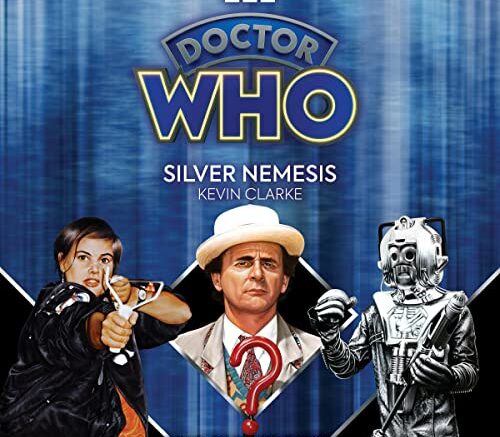
Written by Kevin Clarke
Read by David Banks
Silver Nemesis, even when it was broadcast, was… a bit odd.
As a story, it threw together elements like a Fourth Reich bunch of wannabe-Fuhrers, a couple of idiot skinheads, a 17th century nutjob aristo, addicted to the notion of evil for its own sake, her supposedly-evil but actually quaking servant, the non-linear, and therefore “illogical” nature of jazz music, and, for reasons about as sensible as anything else in the story, the Cybermen.
But it all centres around a statue of the nutjob aristo, Lady Peinforte, cast in the Gallifreyan living metal, validium, and set into a rocket-propelled meteor, moving through the cosmos in a decaying orbit which will see it crash back to Earth in 1988, when effectively all hell will break loose because a) lots of bad people want to control it, and b) it’s clearly got its own bad juju going on, because every time it comes close to Earth, horrible things happen.
With us so far, or would you like some more psychadelics to ease you through?
It gets slightly more formulaic, in scripting terms, by the fact that the statue of Peinforte (in the guise of Nemesis, goddess of retribution, hence the title) is broken up into three pieces – the body, the bow, and the arrow – and that all three need to be put together for the validium’s deadly properties to become active by virtue of critical mass.
So, most of Silver Nemesis as a script is a kind of morris dance between four parties – Peinforte and her not-terribly-hench henchman, DeFlores the leader of the Nazis, and his merry band of supremacists, the Cybermen, who for this story had an extra shiny makeover and weird cricketing gloves – for three pieces of the statue.
That can quickly become tiresome, as any moments of threat can be suddenly undercut by the fact that one of the other parties has a critical part of the puzzle, leaving the sense behind of three episodes of running around to not a very great deal of effect.
Silver Upsides
That said, the story pulls off a few things really well – the arrival of the Cybermen at the end of Episode 1 is effective, not least because it’s full on. They arrive from the sky in a Cyber-ship, rather than, as was by then traditional for the Cybermen, hiding in shadows until their moment of reveal. And they are, in this story, very very shiny – and pleasingly, they’re immune to bullets here, in a way that would have made their Sixties predecessors whatever the Cyber-equivalent of proud and jealous is.
But the story relies too heavily on its whirligigging power-plays, and – which is more serious – it also relies on everybody being at least a tiny bit thick.
The Doctor was clearly a bit thick, setting up this scenario in the first place, endangering humanity, forgetting about the threat, and then getting his sums wrong with the orbit of the statue.
The Cybermen are, to be fair, always a bit thick, but here they seem extra thick, relying on “the human state of madness” for their victory over Peinforte, and, which is worse, being immune to bullets but falling instantly dead from a doubloon, fired by a catapult into their chests. It’s the nadir of the whole “Cybermen are vulnerable to gold” arc that began in in Revenge of the Cybermen and was never better used than in Earthshock.
DeFlores and Co are Nazis – do we need to explain why they’re a bit thick? Ok, just for the record, in storytelling terms, it’s their Wagner obsession and their conviction of their own superiority. And of course the fact that they’re Nazis.
And Peinforte and Richard are a bit thick in terms of Peinforte’s dedication to some spurious notion of “evil,” and her conviction that knowledge of “the Doctor’s secrets” – presumably not including his status as the Timeless Child – will in some way give her victory.
It all ends up feeling clunky and messy, its comedy spurious, its use of the Cybermen somewhat challenging, and the heavy underlying intention of writer Kevin Clarke – who avowedly knew very little about Doctor Who when he wrote the script – that the Doctor’s secrets should include the idea that “the Doctor is God” is almost immediately tedious.
The Cartmell Era
What perhaps put the kiss of death on the story when it was broadcast though is that the resolution to the story is more or less exactly the same as that of the significantly superior Remembrance of the Daleks by Ben “Rivers of London” Aaronovitch just two stories earlier. Gallifreyan tech, classic enemy, competing factions, Doctor programs the Gallifreyan tech to wipe out the classic enemy’s fleet – the beats are idiotically similar, and the two stories should never have been scheduled in the same season, let alone just two stories apart.
It’s this kind of stupidity that underlines my thesis that while fans are happy to chunter about the Graham Williams era and the Chibnall era, it’s actually the Cartmel era that shows the least actual competence in the history of Doctor Who, but that… is very definitely another article.
The point is, there’s very little about Silver Nemesis on screen that actually works, beyond some of the performances – Sylvester McCoy and Fiona Walker as the Doctor and Lady Peinforte in particular.
So the novelization had the chance to salvage something interesting from the mess that ended up on screen.
Fumbled Chances
And then, more or less, just printed the legend. Kevin Clarke adopts the “Terrance Dicks in a hurry to meet a deadline” workmanship that delivers pretty much exactly what appeared on screen and very little else or more to bolster the reader’s or listener’s engagement in the game of high-stakes do-si-do. There’s a little more with DeFlores, giving some of his history and movement that wouldn’t have been worth filming for TV, and a little fun with the power struggles of Cybermen whose leader’s a liar, but essentially, what you remember is what you get in the Silver Nemesis novelization.
Sometimes, that’s enough, but when that you remember is messy and depends on character idiocy to work at all, it ends up feeling like “Fool me once, shame on you, fool me twice, shame on me.”
There is, though, one potential saving grace when we talk about the Silver Nemesis audiobook, and that’s that it’s read by David Banks.
David Banks of course was the Cyberleader throughout the 1980s, from the Cybermen’s return in Earthshock all the way through their final appearance in Classic Who – Silver Nemesis. His vocal performance, his intonations, made for a definitive Cyberman for the era – strong, void of traditional emotions, but still with enough tonal variety to make the Cybermen interesting – something which was missing from the more strictly unemotional Cybermen of the Sixties, post-Tenth Planet.
So the presence of David Banks on reading duties was a real “click to buy” feature for at least this Eighties Cyber-fan.
Sadly though, while we know Banks can still do his Cyberleader voice – he did it just a handful of heartbeats ago in Hour of the Cybermen for Big Finish – there seems to have been a decision taken here to give us a slightly different style of Cyberleader, something lighter and less resonant with crush-your-skull menace.
So you’re not about to get the Cyberleader you remember, even with David Banks in the chair.
You Will Be Upgraded…
Then add to that the fact that the technology for delivering the Cyber-voice seems to have been positioned fairly close to him throughout the reading and what you get are other characters whose speech occasionally comes out lightly cyberized, while the heavy-duty Cyberleader who terrorized the Eighties never puts in a full or a convincing appearance to elevate the confused runaround nature of the script.
Bottom line, there are lots of reasons to want to buy the Silver Nemesis audiobook. But, despite the clout of the reader, there are very few reasons to actually go ahead and buy the Silver Nemesis audiobook. If you loved the on-screen version, you’re getting mostly that but with confusingly cyberized character-voices and a less imposing Cyberleader.
If you weren’t that keen on the on-screen version, there’s little to attract you to this version, either.



Be the first to comment on "Doctor Who: Silver Nemesis"